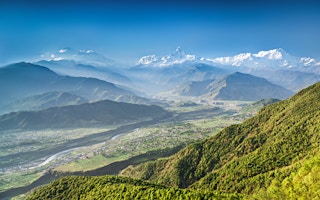Nepal’s forests store more than 500 million tonnes of carbon, new government research has revealed. This is equivalent to about two thirds of India’s total emissions in 2011.
Officials say this is the first nationwide survey of its kind and an important step towards preparing the country for trading carbon stored in forests, a mechanism for which is under discussion by the United Nations Framework Convention on Climate Change.
“Now we are among the few countries that have solid scientific information about the status of its forest carbon,” said Krishna Acharya, a spokesperson at Nepal’s Forest Ministry.
How to pay poor countries for their efforts to preserve and store carbon in forests has long been a subject of hot debate at UN climate conferences.
As a least developed country, Nepal is eligible to sell carbon to developed countries who want to offset their emissions under the UN mechanism called Reducing Emissions through Deforestation and Degradation (REDD). But no agreement has yet been reached on how to verify and report emissions reductions – and wrangling has long stalled discussions initiated back in 2005.
“
International mechanisms obligate robust measurement of carbon, its verification and reporting, but poor countries have been demanding easier ways to sell carbon as they lack resources.
Ugan Manandhar, forest carbon expert at WWF Nepal
But there are high hopes a deal will finally be made at the UN climate meeting in Paris this December.
“Discussions over forest carbon trade are at the final stage so chances are very high that an agreement will be inked in Paris. This research data will help Nepal to immediately move towards implementation once countries sign the deal,” said Ugan Manandhar, forest carbon expert at WWF Nepal.
In the past Nepal has received money for carbon saved from biogas and micro hydropower projects that reduce forest loss in rural areas.
Officials are now waiting for a global deal on forest carbon. “This data could be used as baseline data for calculating increased carbon stock due to conservation efforts of the communities that could be traded,” said Chudamani Joshi, special advisor to the Finnish embassy in Kathmandu.
“Many questions raised about how much carbon we store have been solved, however the trade and benefits depend on what international mechanism is agreed,” added Acharya.
Forest area decreasing in lowlands, increasing in highlands
The new research – started in 2010 and supported by the Finnish government – has also calculated the forest area of the country. Advanced remote sensing technology called LiDAR was used to map forests in the low-lying areas of Terai and Chure. Experts say this technology provides more accurate data on forest coverage.
The survey shows that the forest area in the Terai (below 110 metres above sea level) is decreasing, whereas the forest area in the middle mountains (below 3000 metres) is increasing. Total forest area increased by over 316,000 hectares in the middle mountains from 1995 to 2010, but decreased by 16,500 hectares in the Terai from 2001 to 2010, said Joshi of the Finnish embassy.
Researchers say growing pressures from rapid migration, human encroachment and illegal tree felling have led to forest loss in low lying areas bordering India. However, in the highlands, large scale community forestry management has restored forest areas and the population pressure has fallen due to out-migration. There are currently more than 16,000 community forest groups in Nepal actively engaged in protecting forests.
Mixed hopes for carbon trade
Some people are hopeful Nepal can benefit from carbon trading. Forests cover about 40 per cent of country and the success of its community forestry has won global recognition.
Donor agencies are already supporting a number of pilot forest projects in Nepal in a bid to work out how money from the carbon trade can be shared with local communities.
“We have been discussing this for a long time, but we don’t have an answer yet. Delays in an international agreement will increase frustration among communities who have high expectations,” said Thakur Bhandari, executive committee member of the Federation of Community Forests User Group Nepal.
However, there are still major disagreements to resolve before a deal is signed – particularly over the reporting and verifications of emission reductions. “International mechanisms obligate robust measurement of carbon, its verification and reporting, but poor countries have been demanding easier ways to sell carbon as they lack resources,” said Ugan Manandhar from WWF Nepal.










